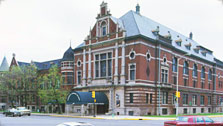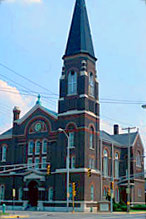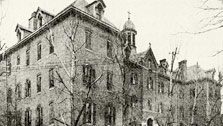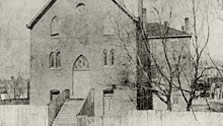History (Page 2 of 4)
Early Growth
The original Lockerbie Square neighborhood covered the four blocks between East St., Michigan Ave., Noble St. (now College Ave.), and New York St. The 1987 Plan indicates that, of the 67 houses in this original area that were entered into the National Historic Register in 1978, 40 were built during the decade from 1860 to 1870. "With reason [the Plan continues] could T. R. Fletcher look back with satisfaction on the return of his real estate investments in Out Lots 51 and 54." In 1884, the McOuat property was sold to a merchant tailor, Jacob Becker, who subdivided it to build rentals, while the McOuat house itself was razed in the 1890's to make room for more small rental units, to meet this same demand.
The nature and number of German immigrants among those who first moved into this area is spelled out in the History section of the 1987 Plan as follows:
Indianapolis was growing rapidly and the skilled professionals, artisans, craftsmen, and workers were in demand. The 1850 Census reveals that the majority of the Germans in Indianapolis that year belonged to the artisan and laboring classes. After they became more established, many of these same laborers became leading merchants in the city in following decades. Of the 329 German immigrants listed as employed, 130 owned property with an average value of $1274.15. The building trades were well represented in the German community of 1850 with 32 carpenters, four brickmasons, two stone masons, one contractor, three plasterers, and four painters.
The abundance of German names associated with the old houses, cottages and shops reflects the importance of the German immigrants in building and shaping historic Lockerbie Square and the area around it. As the "Germantown" area rapidly filled with houses and shops, it is obvious that the immigrants bought lots from the Fletchers, the McOuats, the Holts, and later from their compatriot Jacob Becker to be near the original enclave directly to the south.
German Churches
 Das Deutsche Haus-Athenaeum
Das Deutsche Haus-AthenaeumWhile there are few traces left of the "Germantown" south of New York St., the German presence in the Lockerbie Square neighborhood remains most prominently in what was originally called Das Deutsche Haus-Athenaeum, on the corner of New Jersey and Michigan Streets, and two surviving churches. (A German Methodist Episcopal Church on the southwest corner of New York and New Jersey Streets and a German Trinity Lutheran Church on the northeast corner of Ohio and East Streets have both been demolished). St. Mary's Church was founded to serve the German population in 1857, and built on East Maryland St. It moved to its present building on New Jersey St. in 1912.
 Lockerbie Central United Methodist Church
Lockerbie Central United Methodist ChurchThe other surviving church, the Emmanuel Church, First Congregation of the Indianapolis Evangelical Association, was founded in 1855. In 1871 it changed its name to the First German Church of the Evangelical Association of North America in Indianapolis, and in 1883, the congregation having grown dramatically, it moved to a building at the corner of New York and East Streets. This building was designed, suitably enough, by a German immigrant architect, Diedrich A. Bohlen, who designed many other buildings in the neighborhood, and lived in the neighborhood himself. (insert LCUM Church photo here) Sunday School lessons were taught in German until 1907, and services held in that language until 1909. By 1923, the pastor wanted the parsonage, built just south of the church, moved to the suburbs, because "the neighborhood was not too desirable as a place to rear a family." Nevertheless, both the congregation and the parsonage remained, and the church still stands, as Lockerbie Central United Methodist Church.
Charitable Institutions
 Little Sisters of the Poor in 1875, on the north side of the 500 block of Vermont St.
Little Sisters of the Poor in 1875, on the north side of the 500 block of Vermont St.While neither of them still stands, two sizeable and important charitable institutions, the Home for the Aged Poor of the Little Sisters of the Poor, and St. Vincent's Hospital, attest to the generosity and kindness of the original inhabitants. The first was established by five members of the Little Sisters of the Poor in 1875, on the north side of the 500 block of Vermont St. (insert Little Sisters photo here) Under the loving hands of The Little Sisters, of whom there seem to have been never more than fifteen at a time, the Home expanded several times, doing much good work for over 93 years "supported entirely on what they managed to solicit as alms from the public."
 St. Vincent's Infirmary
St. Vincent's InfirmaryIn 1881 Bishop Chatard helped the other institution, St. Vincent's Infirmary, run by the Sisters of Charity, move into other buildings on Vermont St. built originally for Saint Joseph's Catholic Church in 1873. (insert Infirmary photo here) Like the Home of the Aged Poor and Lockerbie Central United Methodist Church, these buildings were designed by Diedrich Bohlen. St. Joseph's had outgrown them and moved to a new building at North St. and College Avenue. The parish was dissolved in 1877, but the church, rectory and hall still stand as part of the Chatham Arch IHPC Historic Area. St. Vincent's Infirmary flourished, and by 1889 was treating over 600 patients a year. That year it moved to a new building at South and Delaware Streets. It moved again in 1913, as St. Vincent Hospital, to Fall Creek, and, in 1974, to 2001 West 86th St. By 1892 the diocese had disposed of the last of "Chatard's Subdivision"; many of the lots became the property of the Indianapolis Glove Company.

 Members
Members